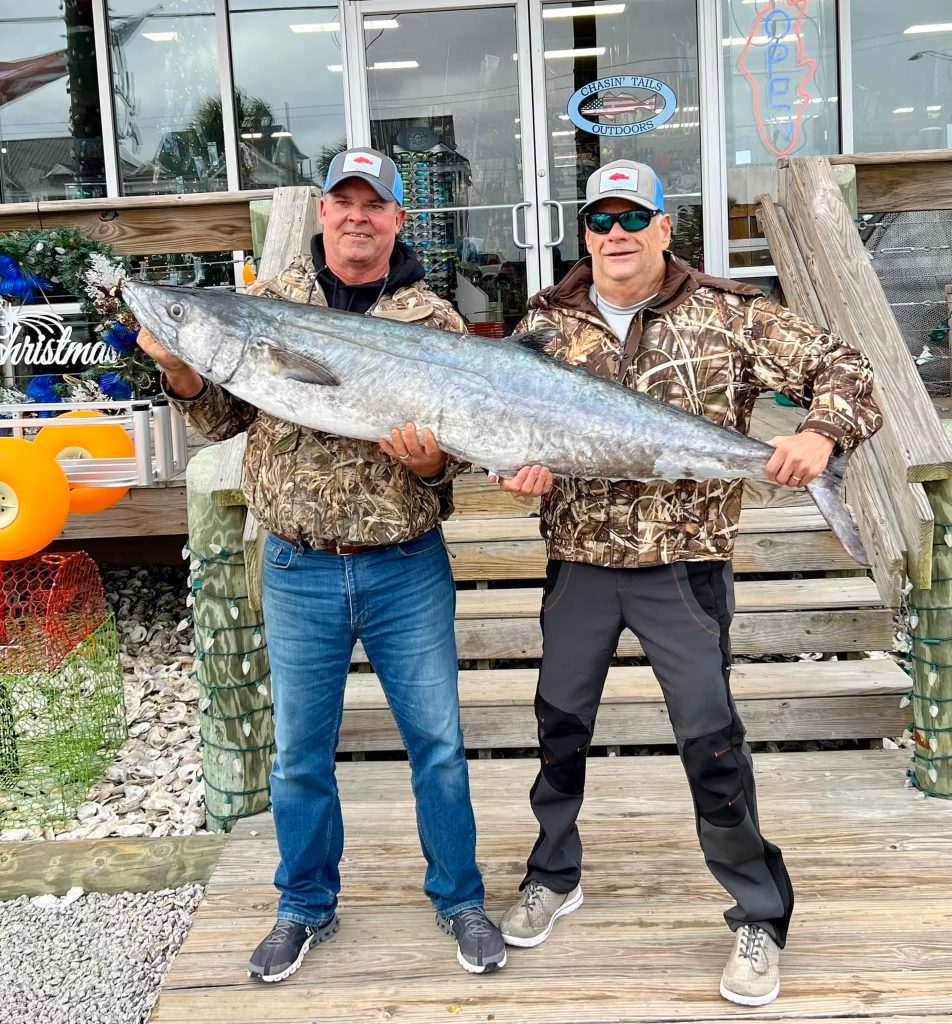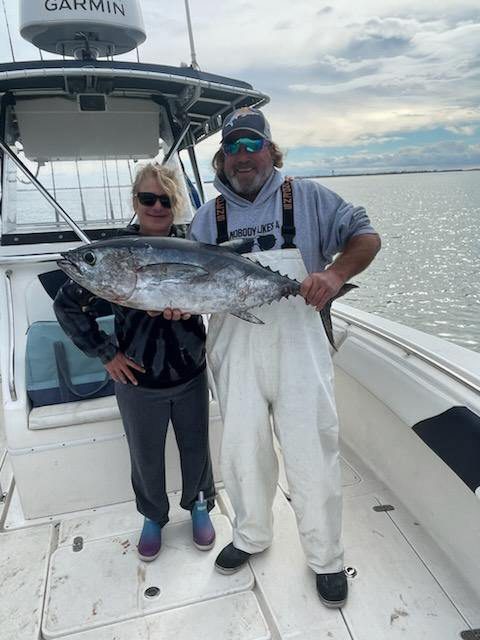Morehead/Atlantic Beach – March 2024
Frank, of Chasin’ Tails, reports that anglers have been finding good black drum action while fishing inshore structure with bottom-rigged shrimp or sand fleas. A few sheepshead are mixed in for those utilizing these same tactics.
Some scattered, early sea mullet have started to show in the Turning Basin. This bite only picks up moving into March as more schools push in through the inlets.
Anglers fishing in this same area can find some bluefish and gray trout while jigging in the deeper holes with Stingsilvers or Beach Bum Lure style casting jigs.
Inshore efforts are producing a fair number of red drum and speckled trout.
Out around Cape Lookout, there are black drum and scattered red drum.
When a window opens up, the nearshore bottoms are producing some nice black sea bass for those set up with squid wings.
The deeper bottoms are producing the larger sea bass, triggerfish, yellow eye snapper, and vermilion snapper.
Gulf stream runs have found decent wahoo fishing.

Eric Floyd and Howard Tucker, of Beaufort, caught his 67.9 lb. king mackerel on the east side of Cape Lookout using live menhaden.
Joe, of Carolina Traditions Guide Co., reports that black sea bass have been staged up in good numbers over rocks and ledges in the 60-80’ range.
When making the run nearshore and offshore, have some casting gear ready in case you run across schools of false albacore as they start to move in.
Inshore trips are seeing some good speckled trout action in terms of quality fish. Suspending baits such as MirrOlures are enticing strikes from trout up to 27”.
Black drum are all over the place right now. Hard structures such as bridges, docks, deeper oyster beds, and the Cape Lookout Jetty are all places seeing action.
Tautogs are also hanging around some of the bridges and the Port Wall.
As we move into March, we will see bluefish trickling back into the area, and anglers on the beaches and around the inlet will start to see some sea mullet and pufferfish showing up.
Daniel, of On Deck Fishing Charters, reports inshore anglers are having success fishing structure such as the bridges, docks, and rocks for sheepshead and black drum. Fishing with fresh shrimp rigged on a jig head is a great and simple setup that will entice bites.
At any time, the area could see the first run of sea mullet in the inlets and back to the port area. Sam’s Gitter rigs tipped with Fishbites strips or fresh shrimp will help put some fish into the cooler.
If you see a calm, clear day in the forecast, use that time to get out and target the schools of red drum moving around in shallow water areas.
Chris, of Mount Maker Charters, reports that wahoo action out on the break will continue to be steady through this last bit of winter and into early spring.
Bottom fishing will begin heating up for those species that will be in season, such as triggerfish, vermilion snapper, grunts, porgies, and some big amberjacks.
Anglers looking to fish nearshore will continue to target the great black sea bass bite on the local reefs and live bottom as we await the arrival of our spring species. Atlantic bonito, false albacore, gray trout, and the occasional red drum school will start showing up on these same structured areas off the beach.
Closer to the beach, the surf line, rock jetties, shoals, and inlet areas are holding red drum, black drum, scattered speckled trout, and sheepshead. A variety of baits including fresh bait shrimp, crabs, and soft plastics are enticing strikes.
Most of these same species (red drum, black drum, sheepshead, and trout) are holding inshore as well, with bait options remaining the same. The red drum and speckled trout are the two responding well to soft plastics, though a slow retrieval is critical when fishing in these cold water temperatures.

Missey Bubnick, of Carolina Beach, found this citation blackfin tuna while fishing out of Morehead City using a Yo-Zuri Chugger.
Byron, of Going Bogue Outdoors, reports that as water temperatures start to warm up, the vermilion snapper and triggerfish that anglers are running 40+ miles for right now start moving in closer.
Nearshore water temperatures in the upper 40s have slowed down just about everything outside of the black sea bass bite. Thankfully, black sea bass can be some phenomenal fishing when you get over a spot holding a good class of fish.
Moving into spring, anglers will start to see the arrival of early “straggler” dolphin ahead of their spawning run.
Mixed in with them will be a better wahoo bite, as the water pulls up from 72 degrees to the 75-77 degree range.
Yellowfin and blackfin tuna will also start biting as well, so pulling a bird with fluorocarbon on the long rigger should be standard on a day’s trip. Keep wire on the rest of your rigs in order to keep from sacrificing too many wahoo strikes with just the fluorocarbon leaders.
Cody, of Reel Time Charters, reports that wahoo fishing has been decent. The better bite, as it typically is, has been around the new and full moons.
Blackfin tuna are always a good option to see mixed in during these cold-water months. All of our pelagic species will be holding in that 30+ fathoms range this time of year.
Bottom fishing remains strong, with a bunch of triggerfish and nice-sized vermilion snapper for anglers looking to load up a cooler.
This is the time of year to catch large black sea bass closer to shore. Anywhere from 15-20 miles out is a good area to start looking for this better class of fish.





